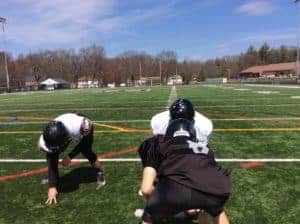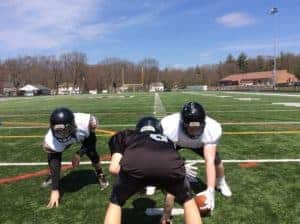One of the new football trends is the Pin & Pull offensive scheme. As most schemes do over time, it continues to evolve through coaching tweaks and innovation.
The Pin and Pull Scheme involves rules for an offensive lineman to pull if a defensive lineman uncovers them. This allows for a more offensive lineman to get involved in both inside and outside zone runs.
In this article, we will teach you about the pin and pull and how teams are implementing it into their offense.
Pin And Pull
Pin and pull concepts have become increasingly popular in the last 5 years.
Similar to how zone, gap, and power schemes work, the pin & pull scheme has rules that allow linemen to communicate with each other to execute the best possible blocking scenario. The base rules for the pin & pull system are as such:
- If uncovered, pull play-side
- Down blocks fill for the pulling lineman, typically in the back-side gap (which tends to be an easier leverage block)
- Running backs follow the pulling lineman for added downfield blocking support
The pin and pull system look similar to the outside zone play, as it still has some of the same characteristics, such as arc releasing and reach blocking.
Please view our complete guide of spread offensive run plays here
What’s The Difference Between Covered and Uncovered?
To fully understand the Pin and Pull blocking scheme, the first rule of thumb is to understand the difference between “covered” and “uncovered.”
Covered Lineman
A covered lineman is when a defensive lineman is lined up in a head-up alignment, such as 0, 2, 4, or 6. If you’re unfamiliar with defensive alignments, take a glance over our breakdown here before you continue.
Above is an example of a player in a “0” technique, covering the center. Coaches more than likely will elect for the center to block head-on and try to out-leverage the defender.
Covered may also mean (depending on the scheme) that the play-side gap has a defender in it. For example, in the picture below, the center is “covered” because there is a player in a 1 technique, occupying the play-side A gap.
Uncovered Lineman
Uncovered linemen are offensive lineman who has players lined up with no defensive lineman lined up over them or a player in a gap backside. These techniques on the defensive side of the ball range from 1,3,5,7,9, and 2i,4i, and 6i’s.
In the above picture, the center is uncovered and will more than likely get involved in the pulling game.
Learn How To Watch Film Properly…
Uncover your opponent’s offensive and defensive tendencies so you can easily build a game plan.
Inside You’ll Find:
- Strategies to pick apart defenses
- How to identify player weaknesses
- How to save time in your weekly breakdowns
What Are The Benefits Of Running The Pin And Pull?
The benefits of the pin and pull are:
- Down blocks are often a high percentage block to outleverage a defender
- Pulling offensive lineman give better angles to linebackers scraping downhill
- It gets backside linemen involved in the play, who are normally hinging or trying to get to the second level
The key is the down block – which can include both Tight Ends and running backs (at the high school level), utilizing leverage and body position to shield defensive linemen.
Variations Of The Pin & Pull
Most people think the pin and pull system must be run out of the spread. Although it does help give the running back a better vision for a cut-back lane, the toss sweep can be just as effective.
Here is a great piece from Seth on the Michigan blog MGOblog, where he details how the Michigan Wolverines successfully run the Pin and Pull from 22 personnel.
At times, we can see up to 3 linemen pulling to the play side toss. As mentioned, down blocks are high percentage blocks that eliminate the most immediate threat (the defensive lineman) away from the play.
What’s unique about this play is the TE coming in motion to down block the defensive end so more defenders can pull around the edge. Very creative from Coach Harbaugh and his staff.
Here is another 22 personnel variant from swgerlarch on Youtube:
Tagging Pin And Pull With RPOs
As RPO (Run Pass Option) schemes became more popular over the years, teams began coupling the RPO scheme with the pin and pull scheme.
Coaches can call one play, tag it with an RPO, and gain a run advantage and a high percentage passing advantage.
The pin and pull scheme can be used to complement base plays such as inside zone and outside the zone, which also have RPOs built off of them.
How To Stop The Pin And Pull
Penetration From The Defense
Penetration from any of the pulling guards can blow the play up in the backfield before it begins. Defenses will often delay blitz or show a blitz last second to disrupt the blocking scheme’s mental part.
If the down blocks aren’t clean from a weaker player (a tight end or running back blocking a defensive end), it can cause a cluster of pulling guards. Offenses like running these types of plays to the boundary may see a cluster, especially with edge penetration.
Setting The Edge
Like penetration, setting a hard edge from a defensive lineman, or outside linebacker blitzing can also cause some clutter. This is why teams have opted to tag an RPO to the play, to put these outside backers in conflict.
If the linebackers do decide to blitz, coaches have added a tag to replace them. The best way to slow down the linebackers and put them in conflict is to tag an RPO onto every one of your pin and pull plays.
Keep Learning
Pin and pull is a great scheme for offenses to get their athletic lineman out in space.
If you liked learning about pin and pull, we recommend you increase your football IQ with our Ultimate Football Guide.
The pin and pull is a pull scheme that allows linemen to get out in space to make effective blocks. Defenses now need to account for the leverage and speed of the other teams. This is why schemes like power reading and pin and pull were created to put the defense at a disadvantage naturally.
If you have base gaps scheme plays like counter and 1 back power out of the spread, the pin and pull scheme greatly complements this play.
Follow @vIQtorySports for more football content on Instagram, Twitter, and Facebook! Also, be sure to check out our podcasts and forum to expand the conversation!





